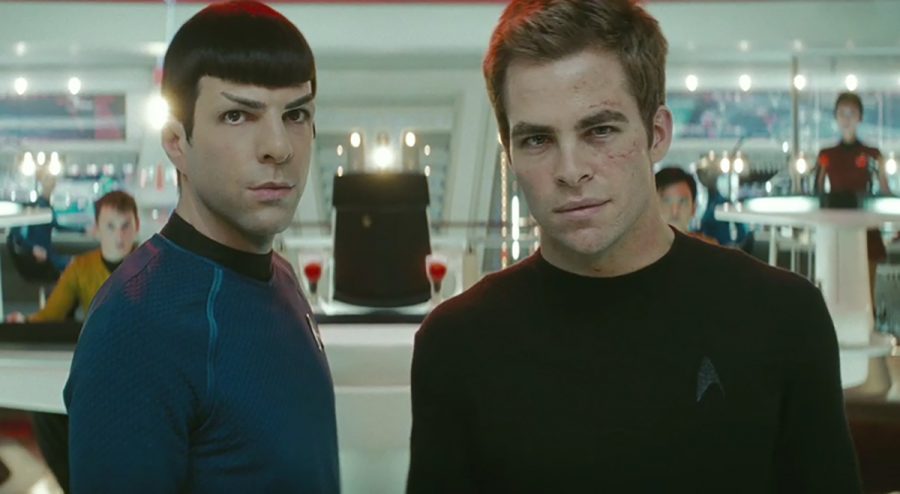‘Star Trek’ in review
Reboot resurrects sci-fi franchise within an alternate reality
More stories from Deanna Kolell
Photo by SUBMITTED
Spock (Zachary Quinto) and James T. Kirk (Chris Pine) eventually learn to work together to try to save their crew and planet earth.
“Space: The final frontier. These are the voyages of the starship Enterprise.”
These familiar words drew audiences back to 1966, when the adventure began.
The voyages of the USS Enterprise continued with 2009’s “Star Trek,” directed by J.J. Abrams, giving the original Starfleet crew the prequel they’ve been waiting for.
“Star Trek” follows James T. Kirk (Chris Pine) the son of George Kirk, a first officer in Starfleet. However, his father died after he was born, thus igniting the universal hero story everyone knows and loves.
Kirk grew up to be a reckless and intelligent man living in Iowa when he meets Captain Christopher Pike (Bruce Greenwood), who encourages him to enroll in Starfleet Academy.
After three years in the academy, Kirk finds himself on board the USS Enterprise alongside half-Vulcan, half-human Spock (Zachary Quinto) and communications officer Uhura (Zoe Saldana).
As Kirk gets his first look at the legendary ship, the strings of “Enterprising Young Men” perfectly encapsulate his sense of wonder and excitement.
https://soundcloud.com/deny-lesmana/ost-star-trek-2009
However, the crew of the USS Enterprise is quickly dismantled when they investigate a distress signal sent from the planet Vulcan. The ship is attacked by Romulans, aliens who are drilling into the planet. When their leader Nero (Eric Bana) requests Captain Pike to come to their ship, Pike delegates command to Spock and promotes Kirk to first officer.
Kirk and Spock make for a new edition of the odd couple. While Spock is cautious and logical, Kirk is aggressive and rash. Kirk and Spock dispute over the course of action to take — whether to regroup with Starfleet or attack the Romulans — and Spock maroons Kirk for mutiny.
Eventually, with the help of Spock Prime — who is from the future — Kirk is able to return aboard the Enterprise and take control. Kirk and Spock eventually learn to work together and try to protect earth from Nero’s vengeance.
J.J. Abrams decided to create this alternate timeline by having Spock Prime use “red matter” to accidentally create a black hole and transport himself and Nero back in time. This gave Abrams the creative freedom to deviate from the original canon.
In fact, some of the original trailers were directly marketed to non-fans of the “Star Trek” saga, including the tagline “This is not your father’s ‘Star Trek,’” focusing on the brief moments of sexuality and copious action shots.
On the other hand, the original “Star Trek” series from the late ‘60s had a different agenda. The creator, Gene Roddenberry, said “(by creating) a new world with new rules, I could make statements about sex, religion, Vietnam, politics and intercontinental missiles.”
The original series was novel in the way it addressed issues of racism, imperialism, human rights, feminism and more, reflecting the counterculture movement of 1960s youth.
Probably the show’s biggest contribution to TV history was its portrayal of a multicultural and multiracial crew, including a Russian navigator, a Japanese-American helmsman, a black female communications officer, a Scottish engineer and an alien first officer.
Although 2009’s “Star Trek” is certainly a thrilling ride and includes the same diverse crew, audiences are no longer shocked that a black woman or a Russian could appear in a blockbuster film.
It’s a new era for Trekkies. The focus isn’t so much on the “morality tale” aspect of the story or addressing prominent cultural issues. Rather, it attempts to appeal to a wider audience base with its fast-paced action and combat sequences.
“Star Trek” has been a thriving part of American culture for 50 years and it will most likely continue into the future, boldly going “where no man has gone before.”
“Star Trek” will play at 7 p.m. Friday, at 2 p.m. and 7 p.m. Saturday and at 2 p.m. Sunday in Woodland Theater.


